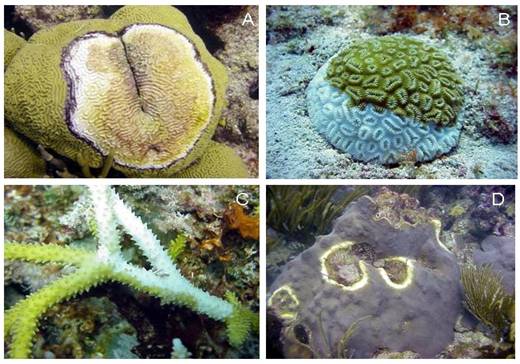Ever heard of the coral holobiont? Its a relatively new term that describes the coral system as a whole. This "whole" included the coral animal, its algal symbionts, bacteria, and fungi. Researchers came to realize that the coral organism is affected by the its community members. For example, bleaching can be caused, not only by the loss of algal symbionts due to temperature increase, but also due to bacterial infections, which similarly result in the breakdown of coral algae symbiosis. Furthermore, bacteria that were once harmlessly living on the coral polyps, feeding off a steady stream of mucous, can suddenly aggregate into these tissue eating mats. This occurs because bacteria act differently when their abundances increase above a certain threshold (quorum sensing). Flesh eating bacteria are easily seen in diseases such as white or black band disease (A&C below).
 |
| Common coral diseases in the Caribbean. (A) Diploria strigosa with black band disease, (B) Dichocoenia stockesii with white plague, (C) Acropora cervicornis with white band and (D) Montastraea faveolata with yellow blotch syndrome. Photos E. Weil, from NOAA’s Center for Coastal Monitoring and Assessment Source: Reef Resilience |
Because of the multiplicity of interactions between corals and their constituents, we need to think about the entire community when we consider the coral organism's health. This isn't easy since most of these organisms are SMALL and SENSITIVE. Most bacteria from coral can't even be cultured in the lab. Neither can most of the symbionts and I haven't heard anything about culturing coral fungi, which is unfortunate since I've heard he's a Fun GUY (get it!). This means there is still a lot of room for new researchers (like you?) to help us understand the complexities of the coral holobiont. For now, I'm working hard on grasping how we use the coral holobiont DNA to understand the kinds of algal symbionts currently associated with the organism. Some of these symbionts may confer temperature resilience, although, this can come at a cost. Dr. Michael Stat and Dr. Ruth Gates wrote a great paper on the algal symbiont in clade D its freely accessible here.
In my next post I will tell you a little more about why this review paper is exciting, especially for the work I will be doing this summer.
No comments:
Post a Comment